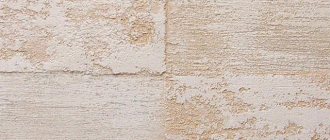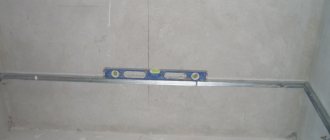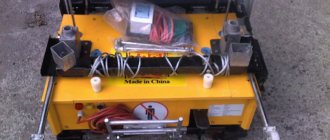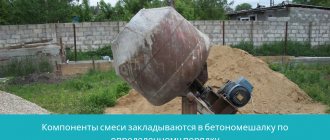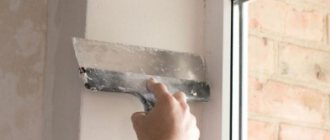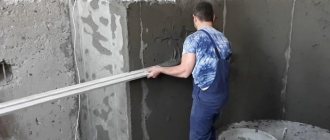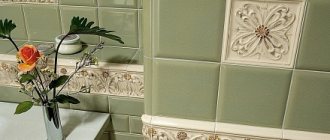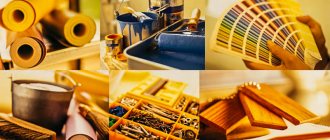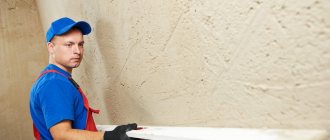APPLICATION AREA
A technological map (TC) has been developed for plastering work on concrete ceilings. The technological map is intended for use in the development of Work Performance Projects (WPP), Construction Organization Projects (COP), other organizational and technological documentation, as well as for the purpose of familiarizing workers and engineers with the rules for carrying out work on installing roofing from asbestos-cement sheets.
When linking the map to specific objects and conditions of work, the volume of work, the need for material and technical resources, the calculation of labor costs and the work schedule are subject to clarification. The technological map has been developed in accordance with the requirements of the following regulatory documents:
1. SP 48.13330.2011 “Construction organization”;
2. GOST 24297-87 “Incoming inspection of products. Basic provisions";
3. SNiP 12-03-2001 “Labor safety in construction. Part 1. General requirements";
4. SNiP 12-04-2002 “Labor safety in construction. Part 2. Construction production";
5. SP 12-135-2003 “Labor safety in construction. Industry standard instructions on labor protection."
6. PPB 01-03 “Fire Safety Rules in the Russian Federation”;
7. SanPiN 2.2.4.548-96 “Hygienic requirements for the microclimate of industrial premises”
8. GOST 7502-98 “Metal measuring tapes. Technical conditions".
9. GOST 9416-83 “Construction levels. Technical conditions".
10. GOST 12.4.011-89 SSBT “Means for protecting workers. General requirements and classification";
11. GOST 12.4.103-83 SSBT “Special protective clothing, personal protective equipment for legs and arms. Classification";
12. ENiR “Unified standards and prices for construction, installation and repair work. A common part";
13. “Guide to the development of technological maps in construction” (M.: TsNIIOMTP, 2004).
Caring for plastered ceilings
The ultimate goal of plastering the ceiling surface is to apply a final finish - interior paintwork. In order for the result to allow you to comfortably operate the room, it is necessary to ensure proper care of the freshly laid ceiling plaster:
- When installing gypsum material, you should open the windows for ventilation, ensuring a slight draft in the room.
Draft in the room during finishing work
- When applying cement or synthetic binders, on the contrary, it is recommended to create the effect of a thermos.
- Before applying the topcoat and paint primer, you must wait until the rough finish is completely dry.
- If defects or an uneven surface of the ceiling are detected, all work to eliminate the defects must be carried out strictly before the mixture hardens.
- After the ceiling has dried, before applying primer and paint, you need to dust and sweep the surface.
Final cleaning of the ceiling before applying paint
If cracks form on the surface of the plaster after hardening, the area must be repaired. Applying a paint coating over such a layer of rough finishing will lead to a defect in the ceiling and, accordingly, to a violation of the aesthetic properties of the new interior.
2.1. Requirements for the quality of previous work
Before starting plastering work you must:
— complete installation and general construction work, incl. roof installation;
— make entrances to the building and arrange canopies over the entrances;
— complete the laying of all communications and seal communication channels;
- seal joints and gaps between walls, partitions, ceilings, as well as joints between window, balcony and door blocks with elements of external and internal enclosing structures;
— install window sills;
— test the internal plumbing, heating and sewerage systems;
- insulate the room and ensure its temperature is not lower than +10 ° C and air humidity is not more than 60%, as well as drying damp places;
— check the strength and stability of the scaffolding;
— illuminate workplaces;
— provide installations for communication between plasterers and the driver with light or sound alarms;
— deliver tools, equipment, devices and materials to the workplace;
— check the mechanisms at idle, carefully inspect the hoses, eliminate kinks and kinks;
— rinse the hoses with lime milk;
— correct all detected defects and deviations from the tolerances established by SNiP 3.03.01-87 “Load-bearing and enclosing structures” during the construction of internal walls.
2.2. Requirements for the materials used.
1. Wet plastering of the surfaces of walls, partitions, ceilings and other structural elements of buildings and structures under construction, in accordance with the requirements of the chapter of SNiP for finishing coatings of building structures, is allowed as an exception due to the design, special operating conditions and the impossibility of using industrial types of surface finishing.
2. For ordinary plasters, cement, cement-lime, lime, lime-gypsum, gypsum, clay-lime and plaster mortars are used.
3. Selection and use of solutions for ordinary plasters, depending on the humidity conditions in which buildings and structures, premises and individual structural elements will be located during operation (Instructions for the preparation and use of building mortars CH 290-74)
4. Dry plaster mixture is delivered to the construction site by closed vehicles in kraft bags or in steel bins. The mixture is delivered in advance, providing a supply for 1.5 work shifts, and stored in conditions that exclude the possibility of moisture getting into it. The moisture content of the dry mixture should be no more than 1.5%.
The dry mixture is supplied to the floors using a lift or winches. To prepare the plaster mortar, small-sized mixers SB-43 A are installed.
First, half the required volume of water is poured into the mixer, then, with the mechanism turned on, dibutyl phthalate-stabilized PVAE or SKS-55 GP latex stabilized with surfactant OP-7 or OP-10 is introduced in an amount of 10 - 15% of the volume of the aqueous latex dispersion.
After 2 - 3 min. While stirring, the dry cement-sand mixture and the rest of the water are loaded into the mixer. The total time for reweighing all components is no more than 10 minutes.
The mobility of the solution in the first case should correspond to 10 - 12 cm of immersion of a standard cone, in the second - 8 - 10 cm. The solution should be prepared in small portions, which can be used before the cement begins to set.
Plaster compositions are applied to the surface using a non-compressor nozzle, to which the composition is supplied via a SO-48A mortar pump.
What characteristics should you pay attention to when choosing
When choosing the right plaster mixture for the ceiling, you should pay attention to the main characteristics of this building material:
- Chemical composition - there are two types of aggregates for plaster - cement and gypsum. In the first case, the hydraulic binder hardens in wet conditions and is characterized by increased durability and reliability. Gypsum compounds are easier to apply. To achieve increased weather resistance, you should opt for a synthetic binder.
Cement plaster
- Scope of application - when purchasing, you should read the instructions on the packaging - the product should be recommended for installation on the ceiling.
- The minimum permissible thickness of one layer - the consumption of the mixture and, accordingly, the cost of finishing the surface of the floor slab depend on this parameter.
- Special characteristics are porosity, on which the heat and sound insulation properties of the mixture depend.
Gypsum plaster
- Hardening time and strength gain - when drawing up a calendar schedule, this characteristic affects the timing of finishing work.
In addition to the basic properties, attention should also be paid to the adhesion indicator, the size of the solid aggregate, the possibility of applying a textured layer and the thixotropy of the binder.
2.3. Work technology
1. Conventional plasters, depending on the thoroughness of execution, are divided into three categories: simple, improved and high-quality, which are presented in Figure 1, installation of a fence;
a - simple; b - improved; c - high quality; 1 - base; 2 - spray; 3 - soil; 4 - cover
Figure 1 - Types of plaster
Simple plaster is made from two layers of mortar: spray and soil with a total thickness of up to 12 mm.
Improved plaster is made from three layers of mortar: spray, primer and covering layer with a total thickness of up to 15 mm.
High-quality plaster consists of a spray, two layers of primer and a covering layer with a total thickness of 20 mm.
The sequence of technological operations during plastering work, depending on the types of plaster, is taken according to the table.
| Technological operations | Plastering | ||
| simple | improved | high quality | |
| Preparing surfaces for plastering | + | + | + |
| Hanging surfaces | + | + | + |
| Installation of beacons | — | — | + |
| Spray application | + | + | + |
| Application of primer | + | + | + |
| Leveling the applied soil | + | + | + |
| Application of primer (second layer) | — | — | + |
| Leveling the applied primer (second layer) | — | — | + |
| Cutting corners | + | + | + |
| Cutting ceiling rustics | + | + | + |
| Applying a covering layer | — | + | + |
| Grout | + | + | + |
| Finishing slopes and caps | + | + | + |
2. Preparing the surface for plastering involves cleaning the surface from plasters that have lost their adhesion and astringent properties, destruction products, old peeling paint layers, dust and dirt. Cleaning methods and means depend on the chemical composition of the material being cleaned, the nature of the contaminants and deposits. Requirements for the quality of cleaning are determined by the type of finish being designed.
Dust off surfaces before applying each layer of primer or plaster compositions. If necessary, surface notches must be made.
The adhesion of the plaster coating to the base depends on the quality of surface preparation for plastering. For interior decoration of ceilings, walls and partitions, this indicator, according to Table 8 of SNiP 3.04.01-87, must be at least 0.1 MPa.
Grease, bitumen and oil stains (traces of grease), efflorescence, protruding reinforcement, and rust are not allowed on the surfaces to be plastered. The surfaces of the walls are cleaned of mortar deposits by cutting them off with scrapers and plaster hammers, after which the surface is cleaned of dust with a rag.
3. Applying a leveling layer or spray-primer and a covering layer with troweling.
A plaster leveling layer or spray primer and a covering layer are applied to the surface as the sliding form moves. The thickness of the plaster leveling layer is 3 mm, the spray-soil layer is up to 4 mm, and the covering layer is 1 mm.
The covering layer is applied only after the previous one has set.
Plaster layers are applied using mortar pumps with a non-compressor nozzle. In this case, it is necessary to ensure that the amount of falling mortar is minimal, for which the plasterer, when starting to apply the mortar, must set the required length of the mortar jet and its spray pattern depending on the pressure.
Level the applied layer with one and a half layers and rules. In this case, the grater is moved from bottom to top in a zigzag motion, pressing it against the wall parallel to the floor so that an acute angle is formed between the lower part of the grater and the wall. One section should be passed with a trowel twice in mutually perpendicular directions.
The quality of the completed plaster is checked as work progresses by applying a control rule to the surface.
The leveling or covering layer is rubbed using spiral movements of the disk of an electric trowel SO-86 or SO-112, with wetting or (if necessary) with the application of cement-sand mortar for leveling without adding PVA emulsion. At the same time, corners are cut, window and door slopes are trimmed.
Small rooms with floors of no more than 5 m2 are plastered by hand. The solution is applied with a ladle directly from the box, and in hard-to-reach places and in very tight spaces, plaster spatulas are used.
Before it hardens, freshly applied plaster must be protected from getting wet, freezing, drying out, from impacts and shocks. If necessary, artificial drying of the plaster is used by uniformly supplying heated air to the plastered rooms and extracting moist air using ventilation. In this case, at least three times the air exchange in the room must be ensured within 1 hour.
In dry weather, at temperatures of +23 °C and above, the plastered areas must be moistened.
4. The supply of solution by mortar pumps consists of the following technological processes:
— filtering the solution by gravity upon acceptance;
— supply of solution to the bunker on the floors;
— installation and carrying of the hose during work;
— cleaning the bunker mesh from waste;
— washing and purging of the hose with removal of plugs.
A mortar pump operator of the 3rd category and two plasterers of the 2nd category are employed in servicing the mortar pumps.
5. The temperature in the room must be maintained at 10 °C around the clock, at least 2 days before the start and 12 days after the completion of plastering work.
Features of applying plaster to the ceiling
To achieve the desired result and prevent defects, you must follow some recommendations from professional craftsmen:
- When installing a thick layer, the work is carried out in several stages - the thickness of one layer should be no more than 10 mm to ensure quick drying.
Plaster in several layers
- Before preparing a solution from a dry substance, you should calculate in advance the amount required for application to the ceiling. Otherwise, the remains must be disposed of.
- If more than 6 hours pass after preparing the solution, but the mixture has not been applied to the ceiling, you will have to prepare a new material, since the old plaster loses its elasticity.
- You should purchase primer and plaster from the same manufacturer with similar performance characteristics.
If you have to plaster a vaulted ceiling or other structure of increased complexity, you should turn to professionals for help, since such work will be impossible for a home craftsman to do the first time.

